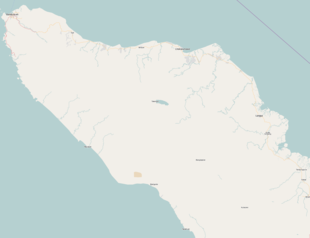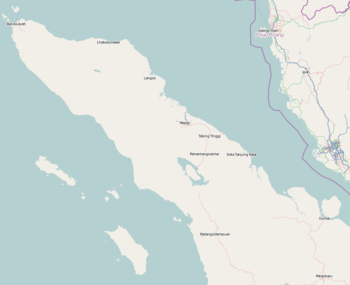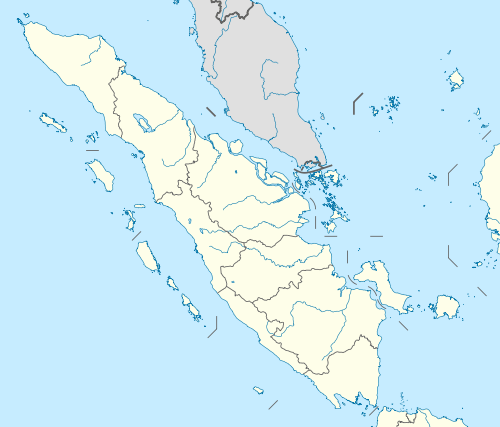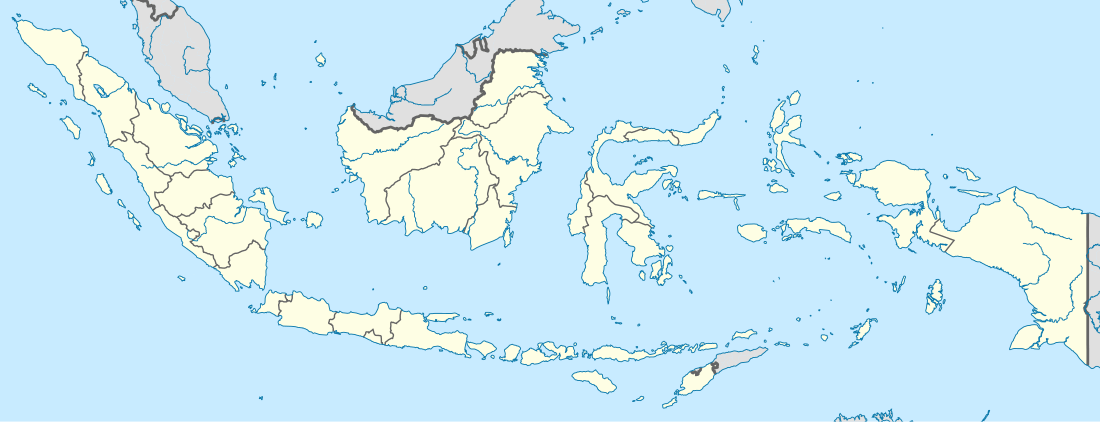Lhokseumawe
Lhokseumawe (Indonesian: Kota Lhokseumawe, Acehnese: Lhôk Seumaw‘è, Jawi: لهوکسيوماوي), is the second largest city in Aceh Special District, in the north of Sumatra, Indonesia. The city covers an area of 181.06 square kilometres, and had a population of 171,163 at the 2010 Census; the latest official estimate (as at 2014) is 180,200.[4] Being between Banda Aceh and the large southern city of Medan, the town is a key regional centre important for the economy of Aceh.
Lhokseumawe Lhôk Seumaw‘è | |
|---|---|
| Other transcription(s) | |
| • Jawi | لهوکسيوماوي |
 Seal | |
| Motto(s): Kota Petro Dollar($) | |
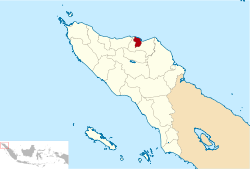 Location within Aceh | |
| Coordinates: 5°11′17″N 97°8′25″E | |
| Country | Indonesia |
| Region | Sumatra |
| Province | Aceh |
| City Founded | 21 June 2001 |
| Government | |
| • Mayor | Suaidi Yahya |
| • Vice | Yusuf Muhammad |
| • Secretary | Bukhari A. KS |
| Area | |
| • Total | 181.06 km2 (69.91 sq mi) |
| Elevation | 2-24 m (−77 ft) |
| Population (2014[1]) | |
| • Total | 180,200 |
| • Density | 1,000/km2 (2,600/sq mi) |
| Demographics | |
| • Languages | Indonesian (official) Acehnese |
| City Growth | |
| • HDI | 77.23 [2] |
| • GDP | Rp. 10.598.205.71 (Million Rupiah) [3] |
| Time zone | UTC+7 (IWST) |
| Postcode | 24351 |
| Area code | (+62) 645 |
| Website | lhokseumawekota |
| For Official Government Website see below of this page | |
History
The name of Lhokseumawe came from the words "Lhok" and "Seumawe". "Lhok" means deep, bay, ocean trenches and Lhokseumawe means the swirling water in the sea along the offshore of Banda Sakti and its surroundings. The city was formerly part of North Aceh Regency. The area is linked to the emergence of the kingdom Samudera Pasai around the 13th century, which later came under the sovereignty of Sultanate of Aceh in 1511.
Pre Colonial Era
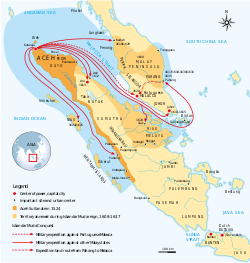
The Sultanate of Aceh was established by Sultan Ali Mughayatsyah in 1511. Later, during its golden era, in the 17th century, its territory and political influence expanded as far as Satun in southern Thailand, Johor in Malay Peninsula, and Siak in what is today the province of Riau. As was the case with most non-Javan pre-colonial states, Acehnese power expanded outward by sea rather than inland. As it expanded down the Sumatran coast, its main competitors were Johor and Portuguese Malacca on the other side of the Straits of Malacca. It was this seaborne trade focus that saw Aceh rely on rice imports from north Java rather than develop self sufficiency in rice production.[5] After the Portuguese occupation of Malacca in 1511, many Islamic traders passing the Malacca Straits shifted their trade to Banda Aceh and increased the Acehnese rulers' wealth. During the reign of Sultan Iskandar Muda in the 17th century, Aceh's influence extended to most of Sumatra and the Malay Peninsula. Aceh allied itself with the Ottoman Empire and the Dutch East India Company in their struggle against the Portuguese and the Johor Sultanate. Acehnese military power waned gradually thereafter, and Aceh ceded its territory of Pariaman in Sumatra to the Dutch in the 18th century.[6]
Colonial Era
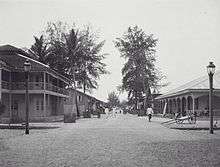
Before the 20th century, the country was ruled by uleebalang Kutablang. in year 1903 after resistance fighters against Dutch colonists weakened Aceh, Aceh began to master.
Lhokseumawe be conquered areas and from then on the status of Lhokseumawe be Bestuur Van Lhokseumawe with Zelf Bestuurder is Teuku Abdul Lhokseumawe subordinate Controeleur aspirants and also domiciled in Lhokseumawe and assistant resident district officer or Regent.
In the second decade of the 20th century, among the entire mainland of Aceh, a small island about 11 km² widely separated by Krueng Cunda River. filled buildings General Government, Military, and Transportation Railway by the Dutch government. Small islands with villages of Keude Aceh, Kampung Jawa, Kuta blang, Mon Geudong, Teumpok Teungoh, Hagu Kampung, Uteuen bayi and Ujong Blang are entirely new 5,500 plural in Lhokseumawe call. Building by building fills this land until the city has realized embryos harbor, market, railway station and the offices of government agencies.
Independence era
Since the Declaration of Independence, the Government of the Republic of Indonesia has not established systemic to this district. At first Lhokseumawe combined with Bestuurder Van Cunda. The mainland population is increasingly crowded, coming from surrounding areas such as Buloh Blang Ara, Matangkuli, Blang Jruen, Lhoksukon, Nisam, cunda and Pidie.
In 1956 the Emergency Law No. 7 of 1956, the autonomous regions formed districts within the region of North Sumatra province, where one of them is the North Aceh district with its capital Lhokseumawe.
Then In 1964 the Decree of the Governor of Aceh Special Region Number 34/GA/1964 dated 30 November 1964, it was determined that Kemukiman Banda Sakti in Muara Dua, the District used its own under the name of the District Banda Sakti.
Based on the Act No. 5 of 1974 on the Principles of Regional Administration, Lhokseumawe be likely to improve the status of the City of, on August 14, 1986 with the Regional Regulation No. 32 of 1986 Establishment of the City of Lhokseumawe signed by President of Indonesia Suharto, which was inaugurated by the Minister of Roestam Soeparjo country on August 31, 1987. Given that it is de jure and de facto Lhokseumawe has become the City of the area of 253.87 km² which includes 101 villages and 6 urban villages in five districts, namely: District of Banda Sakti, Muara Dua, Dewantara, Muara Batu, and Blang Mangat.
Since 1988 the idea of improving the status of municipality began Kotif Lhokseumawe be pursued so that he went on to Law No. 2 of 2001 on the establishment of Lhokseumawe dated June 21, 2001 signed by the President of Indonesia Abdurrahman Wahid, whose territory includes three districts, namely the districts of Banda Sakti, Muara Dua and Blang Mangat. In year 2006 the district of Muara Dua was split into two - Muara Dua and Muara Satu - so Lhokseumawe now has four districts.
Geography
Lhokseumawe City is located between 4˚ - 5˚ North Latitude and 96˚ - 97˚ East Longitude with an average altitude of 13 meters above sea level. Lhokseumawe set the status of a city based on Law Number 2 of 2001, dated June 21, 2001 Lhokseumawe City is divided into 4 districts, 9 residents, 68 villages, and 259 sub-villages with the boundaries of the area, which make Lhokseumawe a semi-enclave within North Aceh Regency:
| Direction | Location |
|---|---|
| North | Selat Malaka |
| South | Kecamatan Kuta Makmur, Kabupaten Aceh Utara |
| West | Kecamatan Dewantara, Kabupaten Aceh Utara |
| East | Kecamatan Syamtalira Bayu, Kabupaten Aceh Utara |
Administrative divisions
Lhokseumawe City is an urban expansion of Aceh Utara Regency and is located on the east coast of Sumatra. Being between Banda Aceh and Medan, Lhokseumawe City holds a strategic position as a distribution channel for trading traffic in Aceh Special region.
When formed in 2001, the city was divided administratively into three districts (kecamatan); since then, the creation of Muara Satu District (formerly part of Muara Dua District) has increased the number to four:
| Kecamatan | Area (km²) |
Population at 2010 Census[7] |
No. of Villages |
|---|---|---|---|
| Banda Sakti | 11.24 | 79,336 | 18 |
| Blang Mangat | 56.12 | 22,850 | 22 |
| Muara Dua | 57.80 | 46,646 | 17 |
| Muara Satu | 55.90 | 32,975 | 11 |
Source : Lhokseumawe Dalam Angka 2013 / Lhokseumawe In Figures 2013[8]
Judging by the number of village officials, Blang Mangat District is the biggest district, consisting of 22 villages, 78 sub villages, and 259 village officials.
Health
Health facilities are available in Lhokseumawe :
| Health Facilities | Total | Unit |
|---|---|---|
| Puskesmas | 6 | Unit |
| Puskesmas pembantu | 12 | Unit |
| Puskesmas keliling | 5 | Unit |
| Polindes | 32 | Unit |
| Doctors Practice | 85 | Unit |
| Dentist Practice | 9 | Unit |
| Drug store | 77 | Unit |
The number of available health workers is:
| Health Workers | Total | Unit |
|---|---|---|
| Doctor | 60 | People |
| Dentist | 5 | People |
| Medical Servant | 399 | People |
| Nurse | 194 | People |
| Midwife | 151 | People |
| Pharmacy personnel | 9 | People |
| Nutritionist | 4 | People |
| Sanitation expert | 7 | People |
- note : Not include private companies, Only Government Facilities and worker
Source : Lhokseumawe Dalam Angka 2013 / Lhokseumawe In Figures 2013[8]
Religious
Religious facilities are available in Lhokseumawe :
| Religious facilities | Total | Unit |
|---|---|---|
| Mosque | 118 | Unit |
| Mushala | 76 | Unit |
| Church | 1 | Unit |
| Monastery | 1 | Unit |
Source : Lhokseumawe Dalam Angka 2013 / Lhokseumawe In Figures 2013[8]
Tourism
Some attractions are rated strongly support the ability of future Tourism Sector is:
- Ujong Blang Beach
- Rancong Beach
- Seumadu Island
- Reklamasi Pusong Beach
- Meuraksa Beach
- KP3 Beach
- Krueng Cunda River
- Waduk Pusong
- Riyadhah Park
- P. Ramlee Village (seniman besar Malaysia, asal Aceh).
Transportation
Airport
- Air : Malikussaleh Airport & Lhoksukon Airport
Seaport
- Sea : Kruengeukeuh Seaport
Road and highway
- Land: Terpadu Terminal
Public transport
One of the unique features of Lhokseumawe city are the motorized rickshaws known as Becak Motor or Becak Mesin. The becaks are found almost everywhere. The fare to ride a becak is relatively cheap and is usually negotiated beforehand before you go.
There are also more public transport like minibuses, known as Labi Labi or Angkutan Kota (Angkot). The Labi Labi can be found easily in medium-to-high congested roads, and The fare to ride Labi Labi is very cheap.
Media
Radio
The city of Lhokseumawe has several radio stations:
| Name | Frequency | Signal | Station |
|---|---|---|---|
| RRI Pro-1, | 89,3-MHz | FM | |
| CITIS FM | 94.4-MHz | ||
| RRI Pro-3, | 95,2-MHz | ||
| Radio SaPa FM | 96.0-MHz | ||
| RRI Pro-2, | 101.9-MHz | ||
| Bujang Salim FM | 101,5-MHz | ||
| Vina Vira FM | - 101,1-MHz | ||
| Istiqomah Arun FM | - 102,7-MHz | ||
| Adyemaja FM | - 103,5-MHz | ||
| Radio Rimba Pase FM | - 106.6-MHz | ||
| Radio Gisa FM | - 107,7-MHz |
TV channel
Lhoksumawe City also has 18 Media TV channel (17 National dan 1 local):
| TV channel | Frequency | Network | Status | |
|---|---|---|---|---|
| National (17 Channel) | ||||
| TVRI Nasional | 30 UHF | TVRI | National | |
| RCTI | 24 UHF | MNC | ||
| SCTV | 34 UHF | Emtek | ||
| MNCTV | 28 UHF | MNC | ||
| ANTV | 22 UHF | Viva | ||
| Indosiar | 46 UHF | Emtek | ||
| MetroTV | 52 UHF | Media | ||
| Trans TV | 56 UHF | Trans | ||
| Global TV | 28 UHF | MNC | ||
| Trans7 | 38 UHF | Trans | ||
| tvOne | 48 UHF | Viva | ||
| iNews TV | 50 UHF | MNC | ||
| RTV | 32 UHF | Grup Rajawali | ||
| Kompas TV | 40 UHF | KG | ||
| NET. | 58 UHF | Indika | ||
| BeritaSatu | 60 UHF | BeritaSatu Media Holdings | ||
| INTV | 62 UHF | Netwave Group | ||
| Local(1 Channel) | ||||
| Puja TV. | 30 UHF | Puja Group | Local | |
References
- Biro Pusat Statistik, Jakarta, 2014.
- "Indeks Pembangunan Manusia 2013 / Human Development Index 2013". Bappeda Kota Lhokseumawe. Retrieved 1 May 2013.
- "Produk Domestik Regional Bruto 2013 / Gross Domestic Product 2013". Bappeda Kota Lhokseumawe. Retrieved 1 May 2013.
- Biro Pusat Statistik, Jakarta, 2011.
- Ricklefs (1991), page 17
-
- D. G. E. Hall, A History of South-east Asia. London: Macmillan, 1955.
- Biro Pusat Statistik, Jakarta, 2011.
- "Lhokseumawe Dalam Angka 2013 / Lhokseumawe in Figures 2013". Bappeda Kota Lhokseumawe. Archived from the original on 9 December 2016. Retrieved 1 May 2013.
Official Government links
For Any information about lhokseumawe city, you can ask directly to official government link below
- (in Indonesian) Official City
- (in Indonesian) Regional Development Planning Board
- (in Indonesian) Regional Network documentation and Law information
- (in Indonesian) Auction services procurement
External links
| Wikivoyage has a travel guide for Lhokseumawe. |
| Wikisource has original text related to this article: |
- (in Indonesian) Facebook Link of Lhokseumawe City
